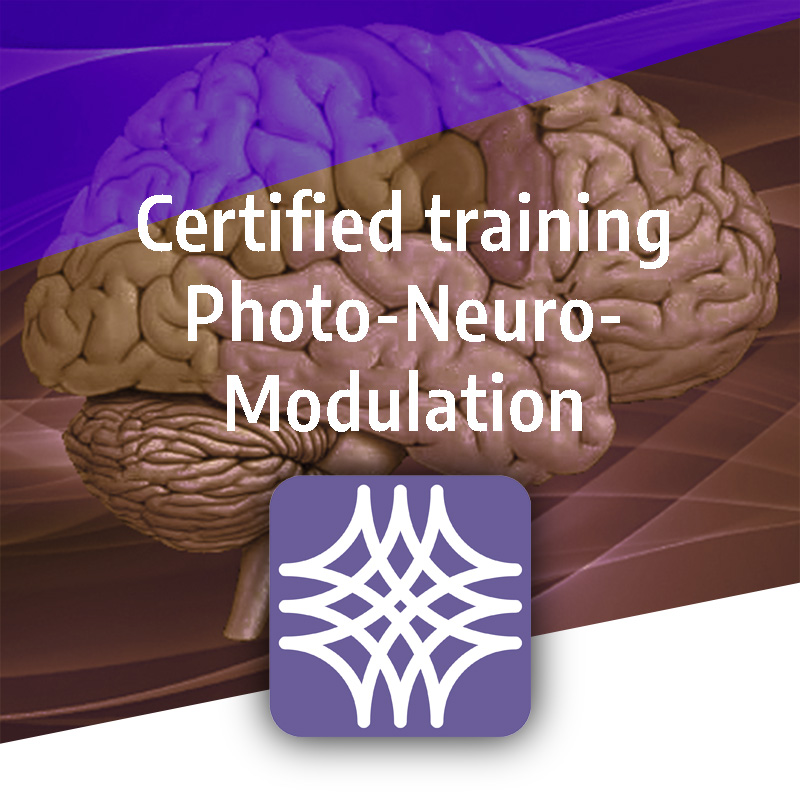
Price incl. VAT: 320,00 €
The COLLL certified online course for the application of Laser Therapy / Photobiomodulation on all types of brain conditions.
The subject of this training of the College for Photomedicine COLLL.org is photobiological therapy for disease patterns of the brain. The photobiological influencing of metabolic processes (PBM = Photo-Bio-Modulation) is an increasingly important part of the medicine of the future, not least in the fields of neuro-rehabilitation and psychiatry.
The aim of the course is to provide an intensive, compact understanding of the quantum biological and cell physiological mechanisms of action of
Photo-Neuro-Modulation, its potential applications for disorders of the central nervous system including lesions, neurodegenerative and psychiatric indications as well as the application parameters and techniques that make PBM therapy effective for the brain.
The course is intended for medical specialists, general practitioners and naturopaths.
It is a comprehensive presentation on the application of PBM therapy in neuroscience for the medical community. It can serve as a guide to neurologists, psychiatrists, neuroscience clinicians, and researchers as well as practitioners and neuro-rehab professionals wishing to get into this pioneering field.
MSc. PBM Farzad Salehpour is a specialist in Brain Photobiomodulation and in the Editorial Board Member of Journal of "Photobiomodulation, Photomedicine and Laser Surgery".
Furthermore, in this course you will find additional interviews conducted by Farzad Sahlepour with the leading researchers in the field of photobiological therapy for brain diseases - like Dr Dan Johnstone, Dr Marvin H Berman, Dr Robert Hedaya, Dr Paul Chazot, Dr Ann Liebert, Dr John Mitrofanis, Dr Liisa Laasko, Dr Leonardo Longo and more - on dementia, Parkinson´s disease, TBI, post concussion syndrome, ischemic brain conditions etc.
The training includes 14 sessions of varying length and an online final test.
The total length of the video tutorials is about 7 h respectively 8 teaching units (UE).
The test will take you about 1 h.
Sessions
Test
The test includes 54 questions and is considered passed if 80% of the questions are answered correctly. You have the option to retake the test several times (no additional cost).
Certificate
After passing the test you will receive your COLLL certificate in Photo-Neuro-Modulation
(Phototherapist Photo-Neuro-Modulation).
After this training, you will be able to fully appreciate the potential and thus the range of applications of photobiological modulation therapy for all kinds of brain disorders. You know how to proceed in individual cases and can independently assess therapy goals, dosage, scope of application and potential therapy effects. You are a phototherapist for neurodegenerative and psychiatric disorders and traumatic brain injuries.
The course concludes with the COLLL certificate "Phototherapist COLLL for Photo-Neuro-Modulation".
On average, our participants complete this training in a relaxed manner within 2 weeks. This gives you enough time to anchor the content. You
can view the course as many times as you like. Basically, you have 1 year to complete the training.
Photobiomodulation (PBM) therapy refers to the non-thermal use of visible to near-infrared light (400 to 1100 nm) to stimulate many biological processes. Nowadays, the applications of PBM therapy are extremely diverse in modern medicine, so that this light-driven modality has gained considerable credibility among the available therapeutic strategies. PBM therapy has been shown to be an effective strategy to promote microcirculation, cellular proliferation, and regeneration, and to ameliorate pain, edema, oxidative stress, and inflammation in many traumatic, acute, and chronic diseases. Given this, there are numerous well-known medical applications where PBM therapy has a significant role to play, such as wound healing, muscle and tendon repair, autoimmune diseases, arthropathies, and rheumatoid arthritis. The underlying molecular and cellular mechanisms of PBM therapy, rely on the absorption of photons by cytochrome c oxidase causing a redox change in the enzyme, leading to increased ATP synthesis and associated effects on cAMP and Ca2+, the release of nitric oxide, and a burst in reactive oxygen species (ROS). This, in turn, promotes a cascade of secondary events such as ROS-mediated activation of key transcription factors like AP-1 and NF-kB and subsequent effects on transcription of genes involved in cellular processes such as proliferation and survival as well as cell migration. Brain PBM therapy is a promising modality by which red to near-infrared light derived from lasers or LEDs is delivered to the scalp to stimulate neural cells and brain function. It is well-known that photons in this wavelength range are able to penetrate the scalp / skull and partially reach the brain tissue. Brain PBM therapy is safe, pain-free, inexpensive, easy to administer, and well-tolerated by the patients in almost all clinical studies. In terms of delivered light dosage, output powers used are normally in the range of a few hundred mW to several Watts spread over a large area, irradiance ranges from 0.005 to 6 W/cm2, with fluence ranges from 0.03 to 20 J/cm2 at the neuronal tissue level or a monolayer of neuronal cells. In humans, the total energy delivered to the head can be over thousand Joules. Of note, mitochondrial cytochrome c oxidase has peaks in the action spectrum at the specific wavelengths of 630-670 nm and 800-880 nm. Keeping this in mind, the specific wavelengths of 600-670 nm, 800-870 nm, 980 nm, and 1064-1080 nm appear to be superior for brain PBM therapy.
There is plenty of evidence suggesting the efficacy of PBM therapy in three major types of brain conditions:
Brain PBM therapy has been shown to increase cerebral blood flow and also augment cerebral metabolic capacity. Moreover, there is growing preclinical evidence to support that brain PBM therapy could ameliorate neuronal oxidative stress, neuroinflammation, and apoptosis and could stimulate neurogenesis and synaptogenesis. In addition to the before mentioned beneficial effects at the neuronal level, there is also evidence of changes occurring at the neurobehavioral level such as cognitive improvement (in several domains, such as learning and memory, executive function, concentration, and attention), antidepressant-like effects, and improved sleep quality.